The Golden Valley Light railway
A 2ft (610mm) Narrow Gauge Railway in Derbyshire
Ashover Light Railway Coach No 4
Restoration Timeline
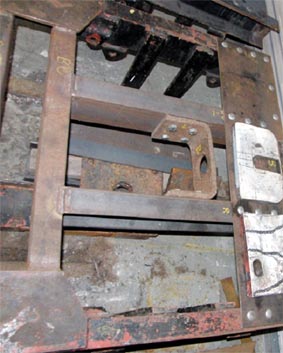
The first piece of partition is back in, and work continues renovating the other pieces. There are effectively 6 pieces, as there are two vestibule partitions, and one offset from the middle.
All the external structural framework repairs are complete, and one external sliding door has been put in place temporarily for a trial fit.
Steve 2 has continued with bogie improvements. Both bogies now have coupling pockets, one new and one original, and work has started cutting out the parts to allow a drawbar to be fabricated.
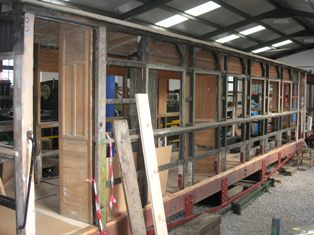
By early 2011 Barry has completed a large part of the requierd work on the underfloor and end areas of the coach.
The actual floor of the coach is now receiving attention. The florboards have been lifted, accessed and those capable of rused are now being relaid
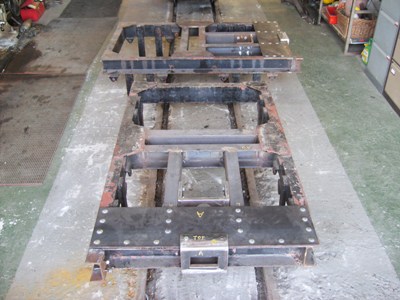
Re-engineered bogie frames showing new transverse and longitudinal beams welded in place, fabricated drawbar reaction plates and outer decking installed. Short extensions welded to sideframes for attachment of hand brake pedestals.
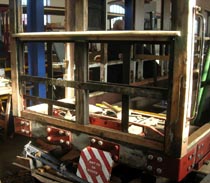
As can be seen in the picture on the right, the the west end corner posts have been restored and work has now moved to the east end, which will receive similar treatment.
On the underframe, missing items , eg. King and Queen posts and truss rods are being replaced and also the King post stretchers
More work has taken place on the replacement bogies, including frame modifications, and re-turning of the wheels and axle bearing journals.
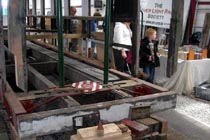
During the Autumn work started on all the supporting metalwork for the underframe. This involved a large quantity of metal being cut and drilled.
The bottom half of the west end corner posts, had wasted away and were cut back to good wood, ready for suitable good wood to be spliced in. The picture on the right shows this and the already replaced, west end underframe headstock.
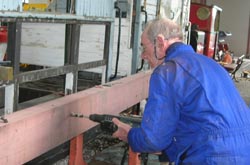
Since the coach arrived we have assumed that the underframe was oak; it isn't entirely, The long bits are pitch pine. This was confirmed by Dennis when he sawed through an old solebar to create a new headstock. Barry has confirmed that the bolsters are oak, when he sawed into them to remove rotten sections.
Work moved to the North Solebar, which would involve another four months work. This would include chopping out and replacing part of an underframe crossmember.
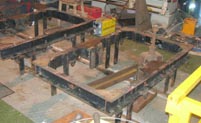
Whilst work continued on the solebars, the windows are being restored off site by Dennis. Paint stripping of the coach is also being undertaken by Pete.
Every coach needs bogies to sit on, so two have been sourced, which require renovation and modification. Steve II has started this vital work. The dropped cross members have been cut out and the abutments cleaned up square ready for welding in new pieces in line.
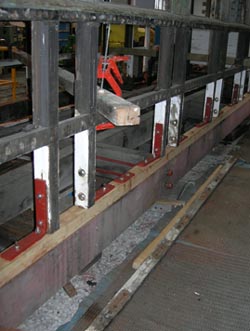
Early in the new year attention turned to removing the South Solebar from the coach. Before this could happen the roof and carriage side were supported with acro props, both end Bolsters were then removed along with all the bolts and fittings associated with the solebar.
The new 30ft piece of wood was then placed next to the removed solebar, which was to act as a template. After many weeks of marking out, drilling & mortising the finished solebar was offered into place. After more fettling the new solebar was fitted to the coach and work then started on a new bottom rail for the carriage side, which sits on the solebar.
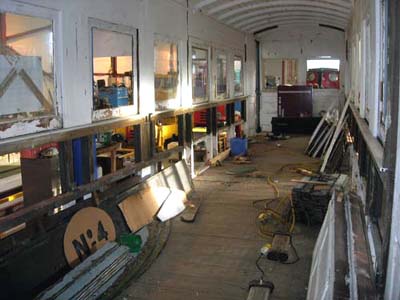
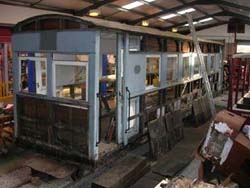
The final work undertaken in 2008 was the removal of all the internal fittings. This included the partitions and bench seats
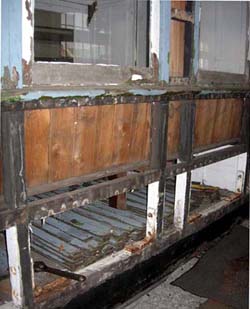
The final two months of 2008 were spent carefully removing, one at a time, the 256 vertical matchboards that clad the coach sides underneath the windows
Many of the screws fastening the matchboard to the coach, refused to budge after 80 years in situ. They were individually heated with a soldering iron. This time consuming work, saw most of them give up their hold
The picture right, shows a section of the coach with the matchboards removed and allows sight of the construction of the frame of Coach No 4. Also seen is the backrest of one of the bench seats (the brighter wood)
Work then moved downwards to where the roof meets the coach sides. The roof covering at the roof edges was folded underneath the roof and held on with strips of wood. These were removed.
Once again it was found additional wooden stripping had been added when the coach had been re-felted. Beneath the roof edge, above the windows are two boards which run the full length of the coach. When Barry started stripping these of paint he noticed a small amount of different coloured paint He then spent an hour per letter removing accumulated layers of paint to expose "Ashover Light Railway"
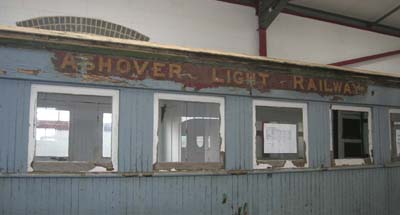
Work has now moved to below the windows. Where the matchboards is being carefully removed, so that as many as possible can be reused.
After months of preparative work, early September saw Barry start removing years of accumulated coverings (canvas and felt) from the roof to expose the roof boards
It was found the original 1924 covering had been covered by felt during its stay at the Bowling Green. During this work the cables that supplied electricity to the internal lights were exposed running on top of the roof boards
Though little actual physical work has been undertaken on Coach No.4 during this period, preparative work has continued apace. Hours of work on the bill of quantities has been carried out and more measuring and minute examination of the coach has been undertaken
With the extensive information gathered so far, suppliers have been sought for the multitude of parts required. Quotes have then been obtained so an accurate cost of restoration can be arrived at.
Two bogies have been sourced, which can be adapted to carry the coach body. Some dismantling of the bogies has been undertaken. The GVLR has been in touch with other NG Railways for help and information on carrying out this project. This has resulted in the purchase of surplus items from other railways. We have also entered into collaborative agreements, with other interested parties to obtain advantageous terms from suppliers, to obtain specialised parts.
Instead of making a "one off" donation to the Ashover Coach Appeal, you could join the Ashover "100" club. If 100 supporters sign up to donate £10-00 plus Gift Aid per quarter for a period of 3 years, our initial target is assured.
So - for the price of a pint and a half of beer each month, you could help to restore this historic coach.
Please see the Ashover Coach Appeal page for full details.
With the Winters edition of "Two Foot Topic" the house magazine of the GVLR, members also received an appeal, requesting donations of money, to help fund the materials needed, for the restoration of ALR Coach No4
The committee of the GVLR will in the near future be widening the appeal, to all interested persons who wish to donate, time and money to see this historic coach once again carrying passengers
Full details of how to help and support the restoration will appear here shortly. The GVLR will be using all means, to raise the required funds. And with its proven track record of major projects, such as the building of the Running Shed, has the capability to see this project through to fruition
At the first Committee meeting of 2008, the restoration of the coach was again discussed.
The spreadsheets produced by the CME were scrutinised. These detailed everything from the two 30ft lengths of timber for the under-frame down to the nails to affix the matchwood sides. An idea of the eventual cost of materials was reached and it was also estimated that some 2,500 hours of volunteer time would be needed to see the project through to completion.
Having ascertained the approximate cost of the proposed restoration, the Committee then turned its attention to fund raising. All possible avenues were discussed, from grant applications to a fund raising appeal. Details of how you may be able to assist both physically and / or financially with this very worthwhile project will appear on this web site shortly.
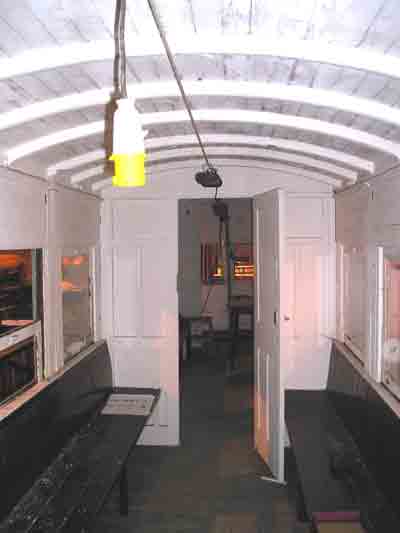
A number of GVLR volunteers spent the weekend working on the coach. It was first cleared of debris and then swept out. Temporary lighting was then installed.
The prolonged task of assessing the coach then commenced. As each item was viewed, a complete list of all the materials needed for restoration process was recorded on a spreadsheet. Later, the homework task of obtaining quotations for all the materials required commenced. Over the next few months, a matrix will be completed of all the parts, the costs, and the volunteer hours required to see the coach restored.
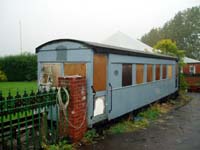
After 21 years of waiting, GVLR volunteers descended on to the site of the Bowling Green at John Street, Clay Cross, accompanied by an articulated lorry with a HIAB facility. The task was to extract ALR Coach No 4 and transport it to its new home.
By late morning, the coach had been lifted from its resting place of 54 years and placed on the lorry. On arrival at Butterley, the coach was lowered on to temporary accommodation bogies and moved in to the NG Running Shed.
When the coach had been safely secured inside its new home, GVLR volunteers cracked open a bottle of champagne in celebration. They then ate their lunch inside coach no 4! The easy bit over, talk then turned to the long job of the restoration which lay ahead.